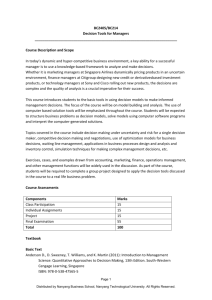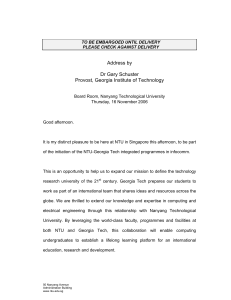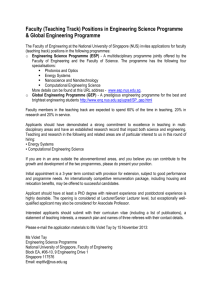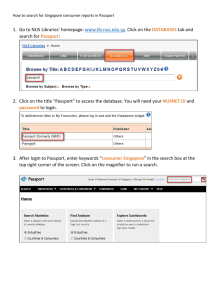The Education System of Singapore
advertisement
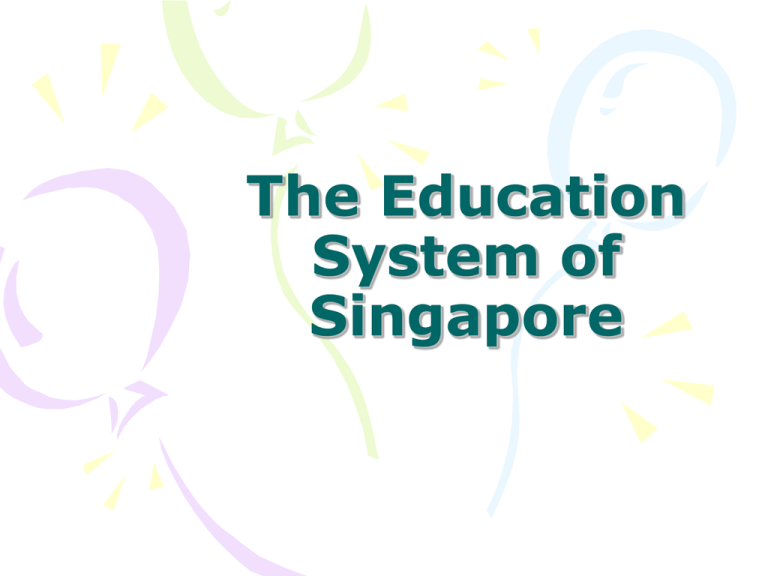
The Education System of Singapore General Education System - The curriculum generally includes programmes in English and a second language -To maximise their potential, students are streamed according to their learning ability before advancing to the orientation stage. pupils are placed in one of three language streams, namely EM1, EM2, and EM3, according to their abilities. • -> Pupils in the EM1 and EM2 streams do English, Mother • Tongue, Mathematics and Science. • -> EM1 pupils may do higher Chinese/ Malay/ Tamil as their • Mother Tongue. • -> Pupils in the EM3 stream do Foundation English, basic • Mother Tongue and Foundation Mathematics. At the end • of Primary 6, students sit for the Primary School Leaving • Examination (PSLE). • - Secondary education : the Special, Express or Normal Course. • -> Special and Express Courses students: • (GCE 'O') Level examination in four years. Special Course • The four-year Special course provides able pupils with the opportunity to study English and the Mother Tongue at a higher level, that is, Higher Chinese, Higher Malay or Higher Tamil. Express Course • The Express course: Unlike pupils in the Special course, pupils study English and the Mother Tongue, that is, Chinese, Malay or Tamil. Normal Course • Students in the Normal Course can opt for the Academic or Technical stream, both of which : (GCE 'N') 'Normal' Level examination in four years of study • if pass, finish GCE 'O' Level examination in the fifth year. After completing the GCE 'O' Level examination… Students can go to : • 1)junior college for a two-year preuniversity course OR • 2) centralised institute for a threeyear pre-university course. --two compulsory subjects, namely General Paper and the Mother Tongue --maximum 4 GCE 'A' Level subjects from the Arts, Science or Commerce courses. --at the end of the pre-university course, students sit for the GCE 'A' Level examination. The three local universities in Singapore • National University of Singapore (NUS) • Nanyang Technological University (NTU) • Singapore Management University (SMU) School Fees and Miscellaneous Fees Unit: S$ Type of Course Operating Cost Government Subsidy Subsidy Rate % Tuition Paid by Stude nts Non-lab-based courses o Humanity/social sciences 19,800 15,700 79.3% 4,100 o Business management 19,800 15,700 79.3% 4,100 o Architecture 24,100 18,950 78.6% 5,150 o Engineering 24,100 18,950 78.6% 5,150 o Sciences/ Computer 24,100 18,950 78.6% 5,150 Lab-based course National University of Singapore (NUS) History • formed through a merger between the University of Singapore and Nanyang University on 8 August 1980 • Benjamin Sheares, President of the Republic of Singapore, became the University's first Chancellor • Dr Tony Tan was appointed the ViceChancellor and the Minister for Education concurrently NUS Vision • Towards a Global Knowledge Enterprise • Building synergies between education, research and entrepreneurship NUS Mission • Advance knowledge and foster innovation, educate students and nurture talent, in service of country and society Facts - NUS has 11 faculties, with an enrolment of more than 23,000 undergraduate and 9,000 graduate students. -NUS enjoys a close teaching-research nexus with 13 national-level, 10 university-level and more than 60 faculty-based research institutes and centres Undergraduate courses • Architecture • Arts and Social Sciences • Building and Real Estate • Business Administration • Computer Engineering • Computing • Dentistry • Industrial Design • Law • Medicine • Music • Pharmacy • • • • • • Science Bioengineering Chemical Engineering Civil Engineering Electrical Engineering Environmental Engineering • Industrial and Systems Engineering • Mechanical Engineering Nanyang Technological University History • Established in 1991 • Formerly known as Nanyang Technological Institute (NTI) • Now abbreviated as NTU • Prof Su Guaning, President of NTU now Nanyang Vision • NTU is now repositioning itself for the knowledge-based economy and to surmount the challenges of new knowledge revolutions, including the life sciences revolution Organisation • The governing body of the University is the Council. It appoints staff and determines the terms and conditions of appointments. It also controls the University's property, finance and general affairs. • The supreme academic body of the University is the Academic Board which has control over admission, examination, instruction and research and has the power to award degrees, diplomas and certificates. Schools Engineering Non-Engineering - The College of Engineering consists of 5 schools. • Nanyang Business School (Accountancy and Business) • Biological Sciences • Communication and Information • Humanities and Social Sciences • NIE (National Institute of Education) • School of Art, Design & Media • Civil and Environmental Engineering • Computer Engineering • Electrical and Electronic Engineering • Materials Engineering • Mechanical and Production Engineering Facts • 1 Graduate Hall and 15 Halls of residence Degree Programmes Courses Degrees Duration of Study Accountancy B.Acc. 3 years Business B.Bus. 3 years Computer Engineering B.Eng.(Comp.Eng.) 4 years Materials Engineering B.Eng.(Matl.Eng.) 4 years Engineering - Bio Engineering - Civil - Environmental - Electrical & Electronic - Mechanical & Production B.Eng. 4 years Biological Sciences B.Sc.(Honours)(Biological Sciences) 4 years Communication Studies B.Comm.Studies (Hons.) 4 years Arts (Education) B.A.Dip.Ed. 4 years Science (Education) B.Sc.Dip.Ed. 4 years

